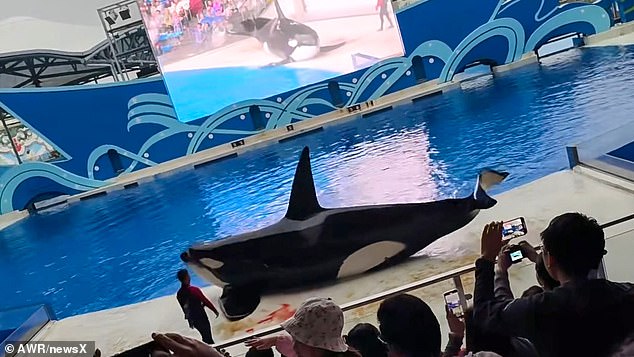This is the shocking moment a killer whale was left to bleed beside its pool following a serious injury at an aquarium show.
The footage, filmed at the Shanghai Haichang Ocean Park, shows the orca being made by a trainer to pose with its tail and head curved upwards as it lies by the side of the tank.
But as it moves its left flipper, blood can be seen pouring out as shocked onlookers gasp in horror.
The killer whale was then seen slipping back into the water, and expectantly sticking its head into the air, before its trainer gives it some fish.
The social media user who captured and shared the footage on November 10 said the animal was injured during the show, which the Haichang Ocean Park confirmed to local media the following day.

As it moves its left flipper, blood can be seen pouring out as shocked onlookers gasp in horror

The poor animal was seen struggling on the side of the pool

Keeping killer whales in captivity is deeply controversial across the world, with many activists claiming that the practice is cruel

Park officials said the orca had been accidentally scratched while playing with toys and that its trainers had taken care of it as soon as they noticed it was bleeding

The killer whale was then seen slipping back into the water, and expectantly sticking its head into the air, before its trainer gives it some fish
Park officials said the orca had been accidentally scratched while playing with toys and that its trainers had taken care of it as soon as they noticed it was bleeding.
Keeping killer whales in captivity is deeply controversial across the world, with many activists claiming that the practice is cruel and often leads to massively decreased lifespans.
Animal conservation groups, including PETA and the Whale and Dolphin Conservation campaign, report massive psychological issues with captive orcas.
Up to 90% of captive male orcas suffer from dorsal fin collapse, a condition often associated with stress.
Often, an orca’s living conditions are far different when captive, and bear little resemblance to wild habitats. They are given very little space to swim, and the water itself is often chemically treated.
On top of this, their social groups are very different differeny, resulting in aggression toward themselves, other killer whales, or humans, which is a result of stress.
This article was originally published by a www.dailymail.co.uk . Read the Original article here. .


